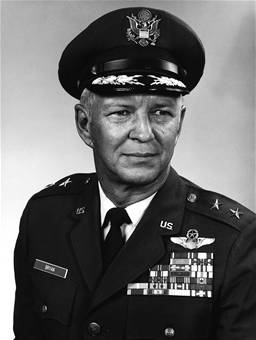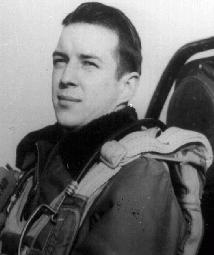MAJOR GENERAL WILLIAM E. BRYAN JR.
Retired June 1, 1974. Died April 6, 2008
Major General William E. Bryan Jr., was Deputy Chief of Staff for Operations and Intelligence, Allied Forces Central Europe, with headquarters in Brunssum, The Netherlands. In this position, he is responsible for the planning and implementation of operations and intelligence at this seven-nation NATO headquarters. He also serves as Senior U.S. representative to the headquarters.
General Bryan was born in Flint, Michigan, in 1921, where he graduated from Flint High School in 1939. He enlisted in the U.S. Army Air Corps in March 1942; entered aviation cadet training in June 1942; and received his pilot wings and commission as Second Lieutenant in February 1943.
During World War II, he served with the 339th Fighter Group in Europe. He flew the P-51 Mustang aircraft in 114 combat missions and was credited with 8 1/2 enemy planes destroyed. At the end of the war in December 1945, General Bryan returned to the United States. He served at Headquarters Tactical Air Command, Langley Air Force Base, Virginia, and then as an advisor to Air National Guard fighter squadrons in Minnesota and South Dakota. In August 1949 he was assigned as operations and training officer for an Air Force Reserve wing at Scott Air Force Base, Illinois.
During the Korean War in August 1950, General Bryan was assigned to the 18th Fighter Bomber Wing, and flew 121 combat missions, again in the P-51 Mustang. He returned from Korea in April 1951 and was assigned to Headquarters Tactical Air Command with duties involving joint air-ground tactical doctrine under the Deputy Chief of Staff for Operations. He attended the Armed Forces’ Staff College, Norfolk, Virginia, from January 1955 to June 1955 and then was assigned to Headquarters U.S. Air Force with the Tactical Fighter Branch in the Directorate of Requirements.
From August 1959 to August 1962, General Bryan served as chief, Air Offense Division, at Headquarters U.S. Air Forces in Europe, Wiesbaden, Germany. On his return to the United States, he entered the National War College, Washington, D.C. After graduation in July 1963, he was assigned to Nellis Air Force Base, Nevada, as commandant of the Air Force Fighter Weapons School and later was vice commander of the 4520th Combat Crew Training Wing.
General Bryan was commander of the 4th Tactical Fighter Wing at Seymour Johnson Air Force Base, North Carolina, from January 1965 until January 1966, when he assumed duties as commander of the 831st Air Division, George Air Force Base, California. His next assignment was as Deputy Chief of Staff, U.S. Military Assistance Command, Vietnam in November 1967. In June 1969 he returned to the United States and was assigned as chief of staff for Headquarters Tactical Air Command, Langley Air Force Base, Virginia.
In December 1970 General Bryan assumed duties as commander of the Nineteenth assumed duties as commander of the Nineteenth Air Force, TAC, with headquarters at Seymour Johnson Air Force Base, North Carolina. He was transferred to Allied Forces Central Europe headquarters in July 1972 with duties as deputy chief of staff for operations and intelligence and as senior U.S. representative to the headquarters.
General Bryan is a command pilot with more than 5,000 hours of flying time. His military decorations and awards include the Distinguished Service Cross, Distinguished Service Medal, Legion of Merit, Distinguished Flying Cross with four oak leaf clusters, Bronze Star Medal, and Air Medal with 23 oak leaf clusters.
He was promoted to the grade of major general effective May 1, 1970, with date of rank August 10, 1965.
Major General William E. Bryan, Jr., USAF Retired, with his family at his side, yet another member of the “Greatest Generation”, was lost to us Sunday, April 6, 2008. Our dad was a true war hero in every sense of the word.
He entered the Army Air Corps in March 1942 at the age of 21 from his hometown of Flint, Michigan. Dad flew 114 combat missions in World War
W II in the P-51 Mustang fighter from 1943 to 1945. Stationed in England with the 339th Fighter Group, he achieved status of “Ace”, reserved only for VSH fighter pilots.
A career military man, in August of 1950 dad again flew the P-51 Mustang on 121 combat missions with the 18th Fighter Bomber Wing during the Korean War.
In 1967 while commanding the 831st Air Division, he had occcasion to fly a mission from Thailand to N. Vietnam. Thus he would declare that he flew fighters in three wars. He was later promoted to Brigadier General and served 18 months in Vietnam.
As a highly decorated command pilot with greater than 5000 hours of flight time, he finished his career as a Major General with 33 years of service to his country at which time he retired to Ocean Springs, Mississippi. His accomodations include the Distinguished Service Cross, Distinguished Service Medal, Legion of Merit, The Distinguished Flying Cross with 4 Oak Leaf Clusters, Bronze Star Medal, the Croix de Guerre, and the Air Medal with 23 Oak Leaf Clusters.
Our mother, Olive Bryan, traveled the world with him, raising their four children: Gale Singley of Pass Christian, Mississippi, Julie Hurst of Norfolk, Virginia, William E. Bryan, III, of Raleigh, North Carolina, and Joni Bryan of Mobile, Alabama. Until her death, several months before Katrina hit, their love story spanned 60 years. Dad has given us a lifetime of wonderful story telling, raunchy old military songs, a love of the music of the 40’s and 50’s and jokes…many, many jokes…laughter and love. Until his death at age 86, he was a living legend. His sister, Ruth Yuille of Flint, Michigan, and his family and friends will miss him more than we can say. Farewell and blue skies for your last flight, Dad.
General Bryan’s will be committed to rest along side his wife, Olive on October 10, 2008 at 1:00 p.m. in Arlington National Cemetery with full military honors in Arlington, Virginia.
DISTINGUISHED SERVICE CROSS
The President of the United States
Takes pleasure in presenting the Distinguished Service Cross to:
William E. Bryan, Major, United States Air Force for extraordinary heroism in connection with military operations against an armed enemy of the United States while serving as Pilot with the 12th Fighter-Bomber Squadron, 19th Fighter Bomb Group, Fifth Air Force, in action against enemy forces in the Republic of Korea during the period of 1 through 21 February 1951.
Displaying superb leadership, dauntless courage, and exceptional aeronautical skill, Major Bryan led his squadron of F-151 fighter aircraft on attacks against enemy transportation facilities and materiel. With total disregard for his personal safety, and ignoring the perils of enemy antiaircraft, automatic weapons and small-arms fire, Major Bryan repeatedly flew over hazardous mountain terrain at low speed and minimum altitude in search of camouflaged enemy vehicles and supplies.
During this period, Major Bryan personally succeeded in detecting 82 vehicles which had been cleverly camouflaged by the enemy. Before destroying these targets, he led his flight in low level passed over the areas pointing out the camouflage techniques, and completely disregarded the damage frequently inflicted upon his own aircraft by enemy fire. As a direct result of this valuable instruction in camouflage detection, Major Bryan’s squadron was able to locate 466 enemy vehicles of which 389 were totally destroyed and the remainder severely damaged.
Michael Robert Patterson was born in Arlington and is the son of a former officer of the US Army. So it was no wonder that sooner or later his interests drew him to American history and especially to American military history. Many of his articles can be found on renowned portals like the New York Times, Washingtonpost or Wikipedia.
Reviewed by: Michael Howard


